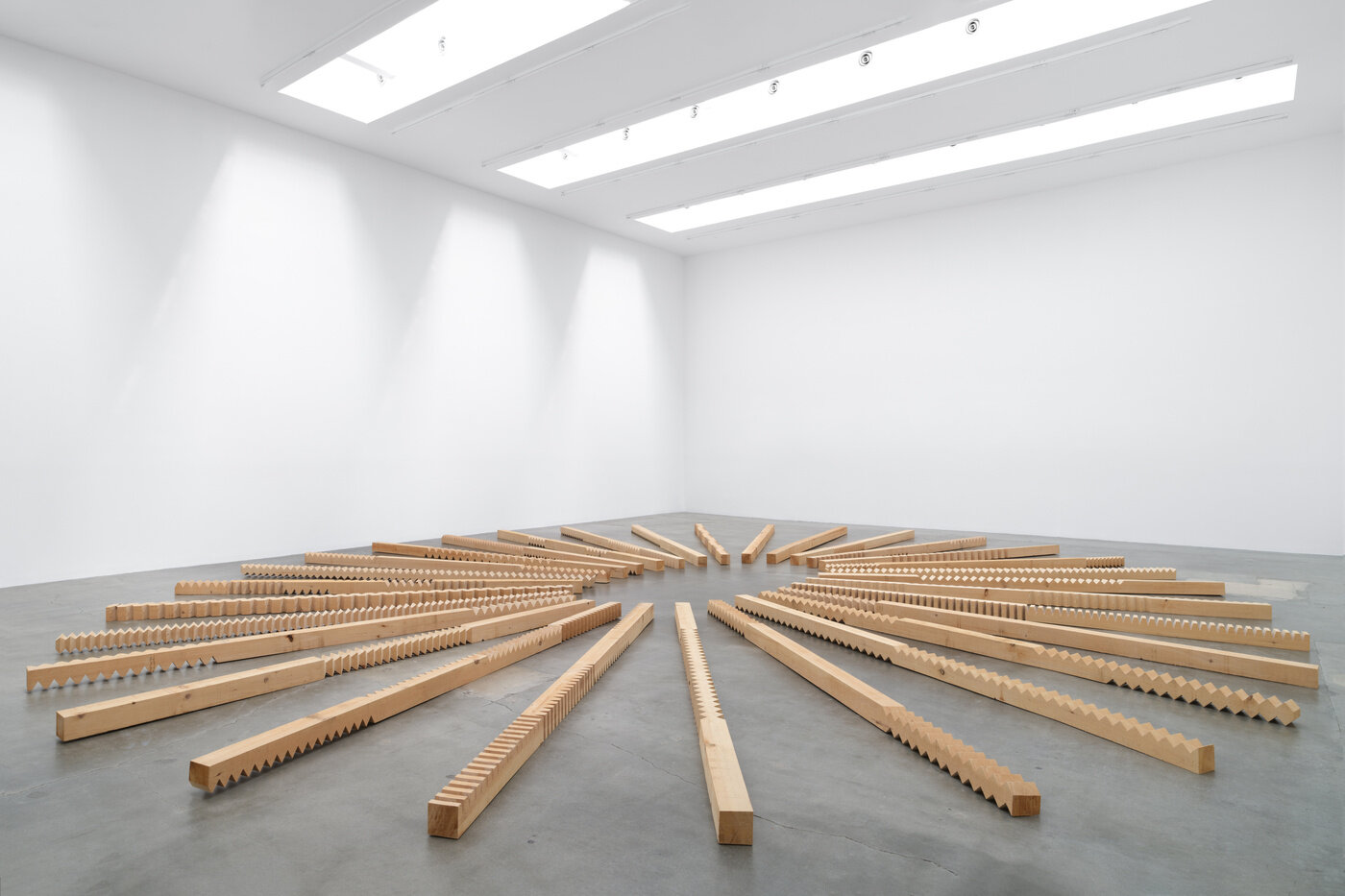ART CITIES: Los Angeles-Thirty Years, Written with a Splash of Blood
 Blum Gallery celebrates its thirtieth anniversary with “Thirty Years: Written with a Splash of Blood,” a milestone exhibition installed across its three locations- Los Angeles, Tokyo, and New York. This presentation is an inter-generational and cross-disciplinary survey of Japanese art from the 1960s to today. The title is a line from Nobel Prize-nominated author Yukio Mishima’s “Runaway Horses”, a celebrated novel that touches on themes of national identity, self-actualization, and the power of reincarnation.
Blum Gallery celebrates its thirtieth anniversary with “Thirty Years: Written with a Splash of Blood,” a milestone exhibition installed across its three locations- Los Angeles, Tokyo, and New York. This presentation is an inter-generational and cross-disciplinary survey of Japanese art from the 1960s to today. The title is a line from Nobel Prize-nominated author Yukio Mishima’s “Runaway Horses”, a celebrated novel that touches on themes of national identity, self-actualization, and the power of reincarnation.
By Efi Michalarou
Photo: Blum Gallery Archive
The exhibition “Thirty Years: Written with a Splash of Blood” reflects on Blum’s first trip to Japan forty years ago, which catalyzed the gallery’s work with Japanese and international artists including foundational exhibitions of artists Yoshitomo Nara and Takashi Murakami, the acclaimed 2012 survey “Requiem for the Sun: The Art of Mono-ha,” as well as “Parergon: Japanese Art of the 1980s and 1990s” in 2019. This show will feature work by key artists from Gutai, Mono-ha, and Superflat movements through today, traversing the decades from the immediate aftermath of postwar Japan, onward. The exhibition features work by key artists from Gutai, Hi-Red Center, Mono-ha, New Painting, and Superflat movements through today, traversing the decades from the immediate aftermath of postwar Japan, onward. The first installment of this multi-location project opens in Los Angeles, spanning over 6,500 square feet of exhibition space. The first work the viewer encounters is Yukinori Yanagi’s “Study for American Art – Three Flags” (2019), a deconstruction of Jasper Johns’s “Three Flags” (1958), made by way of an ecosystem of ants burrowing through painted sand housed inside acrylic boxes. Using the flag as a universal symbol of the US, Yanagi reflects upon the permeability of national identity through his once-removed gesture of double appropriation. That is, Yanagi’s appropriation of Johns’ appropriation of the American flag not only decenters the Euro-American narrative of pop art, but also destabilizes the outmoded role of political and cultural nationalism on the international stage. The first room opens with Susumu Koshimizu’s massive wooden beams that take up the near-entire surface area of the floor in “From Surface to Surface (Wooden Logs Placed in a Radial Pattern on the Ground)” (1972/2004). The work, which consists of thirty wooden beams of Japanese Douglas fir that are each hand-cut with geometric precision, was first presented at Suma Rikyu Park in Kobe, Japan.
In a second room, singularity and resistance, which have been synonymous with Nara’s prolific practice, take on renewed gravitas with “Ennui Head” (2020). The eyes of the sculpture are gouged with the artist’s fingers, while its whipped-cream softness offers an emotional ambiguity that is vulnerable and stone-cold. Nara’s intuitive sensibility for “ennui” resonates with the present moment. In the third gallery, Takashi Murakami’s “DOB in the Strange Forest” (1999) is a vivid display of mushrooms with hundreds of eyes staring back at the viewer. Produced right before his first solo exhibition at Blum & Poe in 1997, the painting features Murakami’s alter ego DOB from the manga series “Inakappe Taishō” (1967–72) by Noboru Kawasaki], making its appearance in this strange forest. An important stylistic precedent is Gutai artist Sadamasa Motonaga’s “In Orange” (1975), whose comedic, anthropomorphic form is imbued with bold animism. The eyes, or negative space dots, of the “Infinity Net” patterns in Yayoi Kusama’s “Abode of Love” (2015) and “Pumpkin” (1999) speak to an obsession with perception and permeability. Perception is a central theme in the Garden Gallery, which includes an immersive installation by Ryoji Ikeda—his “data.tecture [nº1]” (2018) projects data along the floor, thus producing a floating field effect, including onto the bodies of viewers. The molecular data, which comprises hundreds of amino acid chains, are accompanied by pulsating, high-pitch sound frequencies, a familiar device that he used as an engineer and producer for the legendary multi-media collective Dumb Type (formed in 1984) in the 1990s. The upstairs gallery and den combine key works by seven Mono-ha artists, Koji Enokura, Susumu Koshimizu, Lee Ufan, Nobuo Sekine, Kishio Suga, Jiro Takamatsu, and Katsuro Yoshida, alongside contemporary ceramic works by Kazunori Hamana, Yukiko Kuroda, Yuji Ueda, and Akane Saijo. Presented alongside this exhibition is a display of archival photography and ephemera, documenting notable moments in this thirty-year history.
Works by: Koji Enokura, Tomoo Gokita, Kazunori Hamana, Ryoji Ikeda, Yukie Ishikawa, Susumu Koshimizu, Yukiko Kuroda, Yayoi Kusama, Lee Ufan, Sadamasa Motonaga, Takashi Murakami, Kazumi Nakamura, Natsuyuki Nakanishi, Yoshitomo Nara, Yuko Nasaka, Yu Nishimura, Kenjiro Okazaki, Akane Saijo, Nobuo Sekine, Fujiko Shiraga, Kishio Suga, Jiro Takamatsu, Yuji Ueda, Hiroka Yamashita, Tsuruko Yamazaki, Yukinori Yanagi, Katsuro Yoshida, Toshio Yoshida
Photo: Susumu Koshimizu, From Surface to Surface (Wooden Logs Placed in a Radial Pattern on the Ground), 1972/2004, Wood, Thirty parts; 4 3/4 x 4 3/4 x 157 1/2 inches each, Photo: Hannah Mjølsnes, Courtesy Blum Gallery
Info: Curators: Tim Blum & Mika Yoshitake, Blum Gallery, 2727 South La Cienega Boulevard, Los Angeles, CA, USA, Duration: 13/1-3/3/2024, Days & Hours: Tue-Sat 10:00-18:00, www.blum-gallery.com/




Right: Yayoi Kusama, Pumpkin, 1999,Mixed media (acrylic, cloth, paper, styrene foam, wood), 10 1/8 x 9 x 8 1/4 inches, Photo: Hannah Mjølsnes, Courtesy Blum Gallery



Right: Akane Saijo, Eyelid scent, 2023, Ceramic, 16 5/8 x 12 1/2 x 5 3/4 inches, Photo: Evan Walsh, Courtesy Blum Gallery


![Ryoji Ikeda, data.tecture [n°1], 2018, DLP projector, computer, speakers, 275 x 315 x 196 inches,Photo: Dan Finlayson, Courtesy Blum Gallery](http://www.dreamideamachine.com/web/wp-content/uploads/2024/01/010.jpg)

